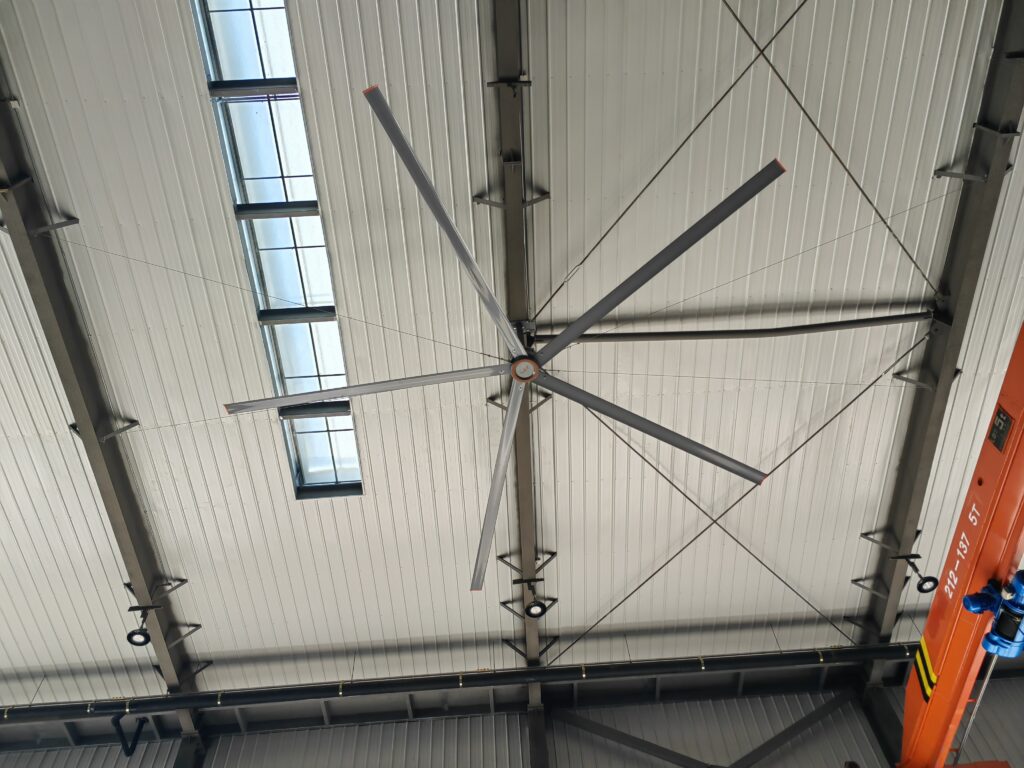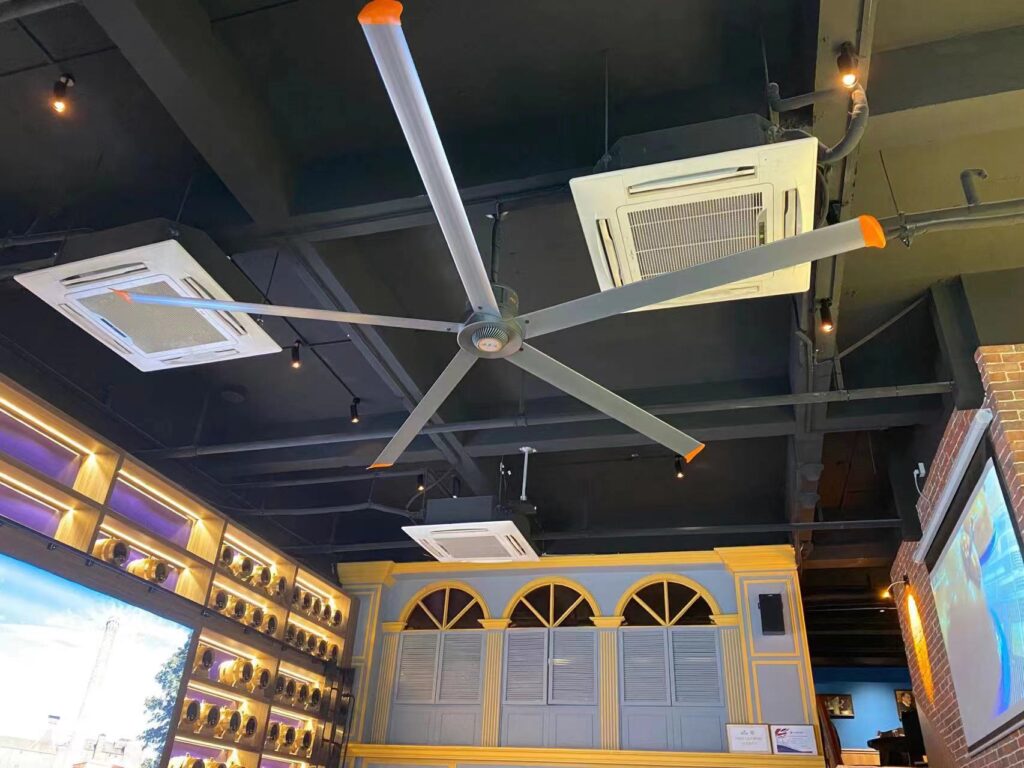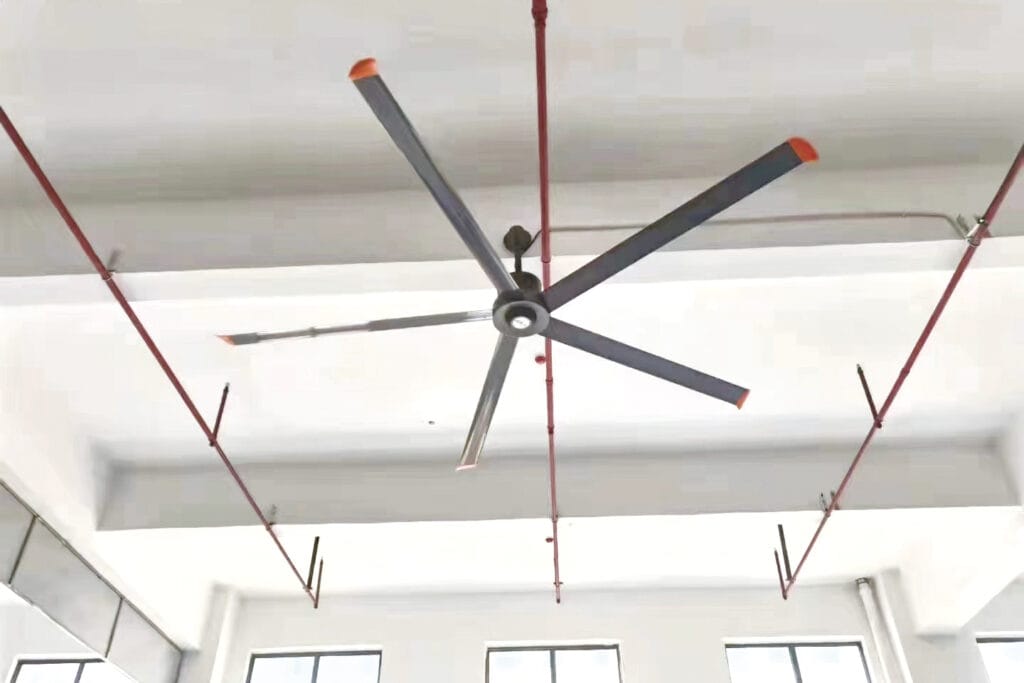Waiting rooms in hospitals and clinics are important areas of contact with patients and their families, and comfort and peace of mind can have a marked impact. Poor air circulation, overcrowding, and odor are common problems that occur in these spaces and may increase stress and discomfort. Healthcare facilities strive to maintain a friendly atmosphere whilst keeping costs of operation at manageable levels. HVLS and industrial ceiling fans, in particular, are one of the best and most affordable options to increase visitor comfort and air quality in hospital and clinic waiting rooms. These ceiling fans hospital waiting room and clinic waiting room ceiling fans provide quantifiable benefits by improving patient comfort ventilation, minimizing HVAC expenditures and aiding in infection control. You and I are going to discuss the challenges, how fans solve them, their integration with HVAC, health benefits, real-life scenarios, as well as an eye opener to healthcare administrators.
Ceiling Fans: A Smart Solution for Waiting Room Comfort
HVLS types of industrial ceiling fans are a breakthrough in cooling solutions in healthcare facilities. Their blade sizes (8-24 feet) generate as much as 400,000 cubic feet per minute and operate at low speeds to produce a mild, diffused airflow that disperses over vast waiting areas. They lower perceived temperatures by 5-7 ° F, enhance waiting area airflow enhancement, and reduce HVAC energy consumption by 20-30, providing ROI in 18-24 months. Their silent work (less than 35 dB) and compliance with the standards of infection control endear them as answers to the question of how to make hospital waiting rooms more comfortable. We outline the problems and solutions provided by fans below, supported by industry practice, and practical implementation.

Challenges in Healthcare Waiting Rooms
Waiting rooms in hospitals and clinics are characterized by unique and specific environmental issues, which influence the experience of visitors and the productivity of the work.
High Occupancy and Poor Airflow
In crowded hospitals and waiting rooms dozens of people may be waiting at a particular time producing body heat and CO2. The air will stagnate without appropriate ventilation creating stuffy environment and making it less comfortable. Much occupancy leads to humidity which worsens the discomfort. Inadequate ventilation does not conform to ASHRAE 62.1 standards of indoor air quality that states that ventilation must be sufficient to ensure that CO2 levels do not exceed 1,000 ppm, which is harmful to occupant health.
Stress and Discomfort
Spending time in a medical center is also a stressful experience, and an unpleasant place hot, stuffy, or humid increases anxiety. Research indicates that inadequate indoor environments may lead to a perceived loss of comfort of 15, which makes wait times seem longer and patient satisfaction grow lower. Hot spots can be seen under large windows or cool drafts under doors, which makes visitors even more uncomfortable in areas with uneven temperatures due to high ceiling (10-20 feet).
Lingering Odors
Hospitals and clinics are prone to medical disinfectants or food odors that were part of a medical procedure and find their way in the waiting room without adequate airflow. These aromas help create an unpleasant environment, which scares patients and family members away. Proper ventilation is essential to spreading of odors and keeping the environment clean.
Risk of Stagnant Air and Pathogens
Stagnant air leads to a high risk of transmitting airborne pathogens, which is of paramount importance in healthcare facilities after the pandemic. Inadequate ventilation leads to the build-up of dust, allergens, and microbes, which can aggravate respiratory illnesses such as asthma. Ventilation is a primary infection prevention measure highlighted by the CDC and, hence, air circulation healthcare waiting areas are a priority.
How Ceiling Fans Improve Comfort
By providing uniform, effective airflow based on the healthcare settings, HVLS ceiling fans can overcome these difficulties.

Maintaining Cooler, Fresher Air
HVLS fans produce a wind-chill effect that cools waiting rooms by 5-7F without removing moisture the way air conditioners do. It covers a large area of up to 22,000 square feet per fan, maintaining temperatures throughout the large spaces, eliminating hot and cold spots. Two 12-foot HVLS fans can stabilize a 3,000-square-foot hospital waiting room, and improve ventilating patient comfort. The air is also inviting and fresh since the sweet smell spreads by the gentle breeze.
Reducing Perceived Waiting Time
Familiar situations shorten the time. Studies of healthcare design indicate that enhanced thermal comfort and air quality decrease perceived wait times by 10-15 years, as patients experience less restlessness. A waiting room where HVLS fans were installed claimed a reduction in patient complaints by 20 percent who said the facility did not feel stuffy because the constant air flow in the room calmed them down and enhanced the overall patient experience.
Silent Operation for a Calm Atmosphere
Clinic ceiling fans have to be quiet to ensure a calming atmosphere. HVLS produces less noise than other types of AC fans and so no noise is produced that could interrupt conversations or instructions to staff (50-60 dB). This helps to maintain the relaxing, restorative atmosphere that hospitals seek to create and fan is therefore perfect in delicate environments.
Integration with HVAC Systems
Ceiling fans are an addition to HVAC systems and will supplement cooling facilities in healthcare. HVLS fans can cut HVAC run time by 20-30 percent by distributing cooled air more evenly throughout the space, allowing thermostats to be set 3-5oF higher in summer (saving 4% energy per degree) and recycles the warm air in winter. The 5,000-square-foot clinic waiting room conserved 3,000 dollars every year on its energy bill by combining two HVLS fans with the HVAC system, breaking the even in 18 months. Building management systems (BMS) can integrate fans with the building management system so fans can regulate their speed based on occupancy or temperature to optimize efficiency and air quality.
Health and Hygiene Benefits
In addition to comfort, HVLS fans aid in health and hygiene, which is essential in a healthcare facility. They reduce airborne proportions of contaminants dust, allergens and pathogens by 15-20 percent, which is compatible with CDC ventilation requirements used to prevent infections. Fans can eliminate any type of mould and bacteria growth by lowering the humidity by 10-15% and reducing the risk of respiratory diseases. Fans were used in a pediatric clinic to dehumidify the environment, which minimized asthma triggers and benefited patients. Their design is mounted on the ceiling, avoiding floor hazards, and is thus safe according to the Joint Commission.

Case Example: A Clinic’s Transformation
A 4,000-square-foot city clinic was plagued by patient complaints regarding stuffy air and waiting hours. Satisfaction was low due to poor airflow and high occupancy resulting in elevated CO2 levels of over 1,200 ppm. Installation of 3 14-foot HVLS fans enhanced air circulation healthcare waiting areas, reducing CO2 by 15 percent and stabilizing temperatures. Patient satisfaction increased by 25 percent, with comments lauding the clean and comfortable atmosphere. The cost of energy decreased by a quarter (22% or 2,500/year), and clinic waiting room ceiling fans reduced the number of health complaints reported by staff.
Beyond Comfort: Staff Productivity and Energy Efficiency
HVLS fans increase the effectiveness of staff work by ensuring a comfortable atmosphere, eliminating tiredness in stressful environments. A hospital waiting room staff reported a 10 percent efficiency increase with the installation of the fans as focus was enhanced by the cooler air. Saving energy is compatible with sustainability programs such as LEED and it allows budgets to be redirected to improved patient care. The 15-20 years lifespan of the fans and less maintenance (cleaning every year) makes them even cheaper to invest in.
FAQ: Common Questions About Ceiling Fans in Healthcare
- Are ceiling fans safe for hospitals?
Yes, HVLS fans comply with UL/ETL safety regulations and installation is mounted on the ceiling, avoiding contact with the floor and promoting the safety of ceiling fans in hospital waiting rooms. - Do fans spread germs in waiting rooms?
No, HVLS fans help to increase the quality of air by diluting the pathogens by 15-20 which is in line with CDC infection control guidelines on air circulation healthcare waiting areas. - Can fans reduce HVAC costs in clinics?
Indeed, HVLS fans reduce both HVAC energy consumption by 20-30% and annual health facility cooling costs by 2,000-5,000 dollars. - Are ceiling fans quiet enough for clinics?
Yes, clinical quiet fans are below 35 dB and do not disturb patients by making a lot of noise.
Conclusion
Poor airflow, odors and overcrowding are problems that affect hospital and clinic waiting rooms, compromising patient comfort and health. HVLS (industrial ceiling fans) offer a ventilation system to patients, specifically to enhance the comfort of waiting areas, lower energy expenses, and aid in infection prevention. They are a smart option because of their integration with HVAC and agreement with healthcare design principles. Ceiling fans hospital waiting room solutions should be considered by the healthcare administrators to improve visitors experience and efficiency. Even 20-plus years of expertise, RTFANS can provide clinics with custom HVLS fans. Change your wait rooms into comfortable, healthy environments today, and your patients and employees will be glad to see it.
